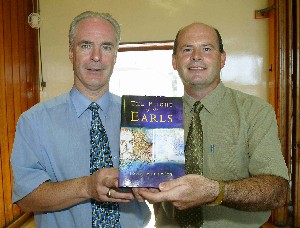
Dr John McCavitt (Head of Politics) presents a copy of his newly published book, The Flight of the Earls (Gill & MacMillan), to Mr Dermot McGovern, Headmaster, Abbey Grammar School. The book will be launched at the Abbey Grammar School on Thursday 26th September at 8pm

The Flight of the Earls in 1607, when Hugh O’Neill, earl of Tyrone and Rory O’Donnell, earl of Tyrconnell boarded a ship on Lough Swilly bound for the continent never to return, is often considered a pivotal moment in Irish history, witnessing the demise of Gaelic Ireland, the onset of protestant ascendancy and penal days for Irish catholics. An event shrouded in controversy, the Flight is typically characterised as mysterious, enigmatic to the point of defying explanation. Even the term, ‘the Flight of the Earls’, conjuring up notions of a precipitate, tragic, perilous escapade tinged with romance and despair, has been the subject of dispute, with some commentators questioning the historical accuracy of terming the departure of the northern earls from Ireland as a ‘Flight’ at all.
The contentious nature of the Flight of the Earls proceeds in no small part from the disputed historical reputation of Hugh O’Neill, earl of Tyrone. Ridiculed by Queen Elizabeth I as a ‘base bush kern (soldier)’, Tyrone, by contrast, had earned himself a reputation on continental Europe as ‘the third soldier of his age’ for the manner in which he regularly trounced Elizabethan royal armies. Tyrone’s self depiction as champion of ‘catholic’ Ireland in the face of the advances of Protestantism is called into question by those who would highlight his collaboration with the protestant English in suppressing the crusade launched by Munster catholics in the 1580s. One of the great icons in Irish nationalist tradition, Tyrone has been gleefully portrayed by his detractors as a violent wife-beating thug and an alcoholic to boot who spent his days in Italy after the Flight wallowing in drunken self-pity.
And yet despite flaws in character, there is strong evidence that Irish catholics, facing unprecedented religious persecution, yearned for his return from Rome, casting him in the role of Moses, the Liberator. Following a ‘great meeting’ of Irish catholics in 1611, including senior catholic clergy, a prominent expatriate, William Meade, a Munsterman, was delegated to travel to Italy in a vain attempt to help co-ordinate Tyrone’s return to Ireland as the military figurehead of a revolt against the protestant English. It was be one of the great ironies of the situation that Tyrone was only to become recognised as the ‘leader’ of catholic Ireland in exile.
The Flight of the Earls is a book concerned with contextualising the earls’ departure by highlighting the events that not only preceded the Flight but those that proceeded from it. A narrative steeped in tales of war, passion, betrayal and derring-do, with heroes and villains of every hue, The Flight of the Earls constitutes a fascinating story spiced with references to spies, assassins and outlaws, kidnapping and hostage-taking, even references to contemporaneous Robin Hoods as well as a curious incident involving witchcraft.
Such was the degree to which war reduced people to desperation that there were horrific scenes of cannibalism during the Nine Years War (1594-1603), a conflict which witnessed increasingly desperate crown forces resorting in some areas to mass murder tantamount to genocide. That Ireland was once a refuge for pirate fleets as powerful as any that plied the Barbary coast is little appreciated.
To a considerable extent too, the Irish ‘diaspora’ originated in this period. The early seventeenth century witnessed Irishmen dispersed as far afield as the Netherlands, Spain, Italy, Newfoundland and even the Amazon. As a direct result of the Flight of the Earls, Irish soldiers, the original ‘wild geese’, saw service in Sweden, Denmark, Poland and Russia, many of them having been transported by the English government. So many themes that have resonated throughout much of modern Irish history had distant echoes in events culminating from the Flight. Thus the issue of extradition arose directly from the Flight when the English government sought to force continental powers to repatriate the fugitive earls. The English government attempted to disarm (decommission) potentially disloyal elements in Ireland.
Catholic absentionism from political institutions also occurred, and the collection of a ‘Catholic rent was organised. Protestant settlers in Ulster, fearing for their future in the event of the oft touted return of the earls to reclaim their lands by force, soon developed a siege mentality, surrounded as they were by a hostile indigenous population.
The in-built ‘apartheid’ complexion of the Ulster colonization project, inspired by biblical teaching that it was fundamentally important to separate the weeds from the good corn, instituted a form of religious segregation in Ulster that far from dissipating with the passage of time is, it seems, becoming ever more prevalent.
Overall, the story of the Flight of the Earls is a tale of epic proportions, an enthralling and momentous episode in the history of Ireland that has lost none of its drama and appeal in the passage of time.